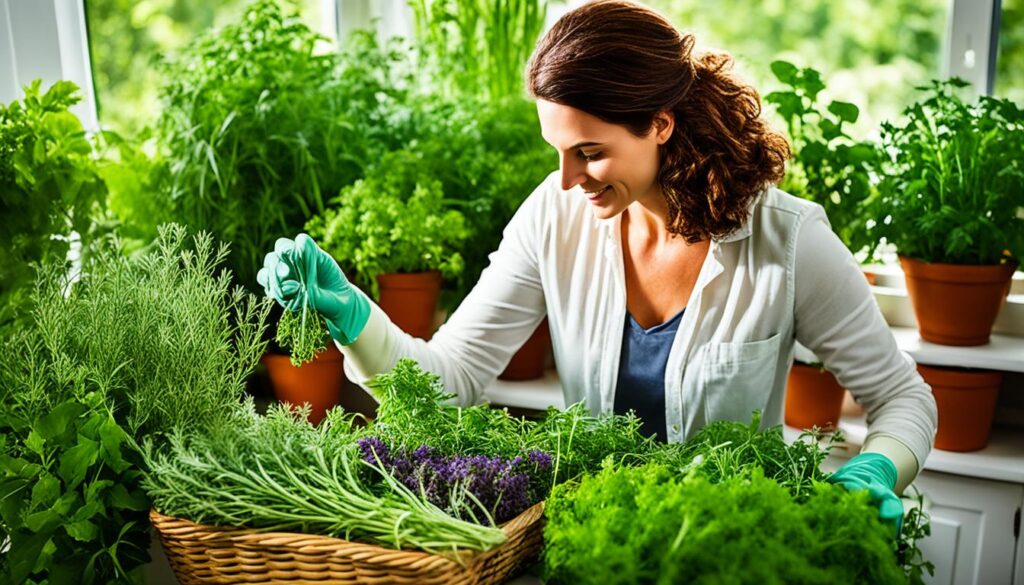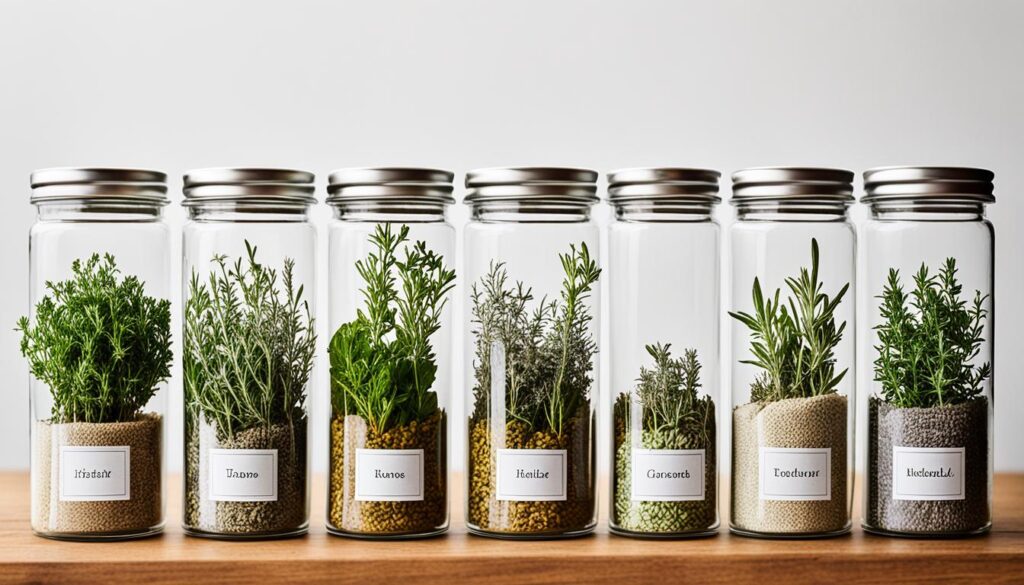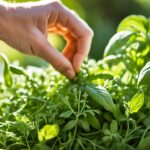Harvesting Herbs: When and How to Harvest for Optimal Flavor
Ever wondered when to pick your herbs for the best taste and freshness? Learning how to harvest herbs can make your cooking amazing. But, do you know the best ways to get the most out of your herbs?
Key Takeaways
- Understand the optimal timing for harvesting different herb varieties
- Discover the best methods for cutting and gathering herbs to preserve flavor
- Learn how to properly store and preserve your freshly harvested herbs
- Explore creative ways to incorporate your homegrown herbs into delicious recipes
- Get tips for growing herbs successfully in containers or small garden spaces
This guide is perfect for both seasoned gardeners and beginners in herb growing. It will teach you how to pick your herbs carefully. Get ready to improve your cooking and enjoy the rich flavors of your herbs.
Understanding Herb Types
When you start a herb garden, knowing the different types of herbs is key. There are two main types: annual and perennial herbs.
Annual Herbs
Annual herbs, or “soft herbs,” live only one year. They include plants like cilantro, dill, parsley, and basil. You need to plant these every year. They are short-lived but add lots of flavor to your cooking.
Perennial Herbs
On the other hand, perennial herbs, or “woody herbs,” can live for many years. They include plants like rosemary, sage, oregano, mint, and thyme. These herbs are easier to care for and can be used in your cooking for years.
When setting up your herb garden, group your plants by their needs. Put perennial herbs in a spot where they won’t get disturbed. This helps them grow well over time.
| Herb Type | Examples | Lifespan | Maintenance |
|---|---|---|---|
| Annual Herbs | Cilantro, Dill, Parsley, Basil | Single Growing Season | Requires Replanting from Seed Annually |
| Perennial Herbs | Rosemary, Sage, Oregano, Mint, Thyme | Multiple Growing Seasons | Less Maintenance, Can Regrow from Roots |
Knowing about the different herbs and how they grow helps you plan a great herb garden. This way, you’ll always have fresh, tasty herbs for your cooking.
Three Rules of Herb Harvesting
Harvesting your herbs at the right time and in the right way is key. It helps keep their flavors and smells bright. Whether you grow annuals like basil or perennials like rosemary, remember these three rules of herb harvesting:
- Harvest herbs often to make them grow more. Picking leaves or flowers regularly tells the plant to keep producing. This way, you get fresh herbs all season.
- Pick leaves in the morning when they’re most flavorful. Herbs are best in the morning, before they lose their oils in the heat.
- Don’t pick leaves after rain or watering, as it dilutes the flavor. Harvest when leaves are dry to keep their taste and smell strong.
By following these herb harvesting guidelines, your herbs will be full of flavor. You can use them for cooking, making herbal teas, or saving for later.
“The secret to great cooking is fresh, flavorful herbs – and the secret to harvesting those herbs is all in the timing.”
Harvesting garden herbs: Tips and Techniques
Knowing when and how to harvest your garden herbs is key for the best flavor and aroma. Whether you’re growing annual or perennial herbs, the right harvesting techniques matter a lot.
Optimal Harvest Timing
Most herbs for drying should be picked just before the flowers open. This is when the leaves have the most aromatic oils. It’s the best time to harvest, as the essential oils are at their highest.
Stop harvesting the leaves of perennial herbs by late summer. This lets the plants store enough carbs to survive the winter.
Leaf vs. Flower vs. Seed Harvesting
- Leaves can be picked anytime, but try to harvest them in the morning after the dew has dried, as the oils are more concentrated.
- Flowers should be harvested in the earliest stage of blooming, when the buds are just starting to open.
- Seeds should be harvested when they are fully mature and dry on the plant.
Understanding the best harvest times and methods for different herb parts helps you get the most flavor and aroma from your herbs.
“The secret to great-tasting herbs is knowing when and how to harvest them at the peak of their flavor.”
Preserving Fresh Herbs
Preserving your homegrown herbs lets you enjoy their fresh flavors all year. Whether you have too many from your garden or want them for cooking, there are great ways to preserve fresh herbs. Let’s look at the best ways to keep your herbs fresh.
Air Drying
A simple way to air dry herbs is by tying them into small bundles. Hang them in a cool, dry spot. This method lets the herbs slowly lose moisture, making their flavors stronger. Choose a spot with good air flow and low humidity, like a shaded porch or attic.
Dehydrating
Dehydrating herbs quickly is easy with a dehydrator. This method keeps their essential oils and nutrients, so they stay colorful and flavorful. Just spread the clean, dry herbs on the dehydrator trays and follow the instructions for drying time and temperature.
Freezing
Freezing is a great way to preserve fresh herbs. You can chop them and freeze in water or oil in ice cube trays, or lay them out on a baking sheet and store them in an airtight container. This keeps their flavor and stops them from getting brittle.
Choosing the right herb preservation method is key for keeping them fresh. With a bit of effort, you can enjoy your homegrown herbs all year.

Herb Harvesting Guide by Plant
Harvesting different herbs requires understanding their unique needs. Knowing the herb harvesting guide for each herb boosts their flavor and yields a rich harvest. Let’s dive into the best ways to harvest specific herbs.
Annual Herbs
Annual herbs like cilantro, dill, and basil do well with regular harvesting. Cutting the leaves and stems just above the leaf nodes encourages more growth. This leaves about 2-3 inches of the plant, ensuring a steady supply all season.
Perennial Herbs
Perennial herbs such as rosemary, sage, and thyme can be picked all season, except in late summer. During this time, don’t cut them back too much. The plants need to get ready for winter.
Herbs with Edible Flowers
Herbs with edible flowers, like chamomile and nasturtiums, are best harvested in the early bloom stage. Picking flowers then captures their best flavor and aroma.
Seed Harvesting
For herbs that produce seeds, like dill and coriander, wait until the seeds are fully dry and mature. This makes sure the seeds are at their best quality and ready to use.
| Herb | Harvesting Technique |
|---|---|
| Cilantro | Cut leaves and stems above leaf nodes, leaving 2-3 inches of plant |
| Rosemary | Harvest throughout the season, avoid late summer |
| Chamomile | Harvest flowers in early bloom stage |
| Dill | Harvest seeds when fully mature and dry on the plant |
By using these herb harvesting guide tips, you can make sure your herbs are at their best. They’ll be ready to add flavor to your cooking.
Storing Dried Herbs
Storing dried herbs right is crucial to keep their flavor and potency. Here are easy tips for how to store dried herbs well.
Airtight Container Tips
For dried herb storage, use airtight containers. Put your dried herbs in clean, airtight containers made of glass or food-grade plastic. Don’t use plastic bags or containers with tight lids because they let air and moisture in. This can reduce the herbs’ essential oils and flavor.
When storing your dried herbs, remember to:
- Choose containers that are opaque or keep them in a dark place to protect them from light.
- Label each container with the herb name and the date you stored it.
- Keep the containers in a cool, dry place away from sunlight or heat.
With the right airtight containers for dried herbs, your dried herbs can stay fresh for up to a year. This way, you can enjoy the taste of your homegrown herbs all year round.

| Herb | Shelf Life in Airtight Containers |
|---|---|
| Basil | 6-12 months |
| Rosemary | 1 year |
| Thyme | 1 year |
| Oregano | 1 year |
| Sage | 1 year |
Using Your Homegrown Herbs
After growing and harvesting your herbs, it’s time to use them in your daily life. You can make delicious herbal teas or flavorful seasoning blends with your fresh herbs. This opens up a world of possibilities.
Herbal Tea Infusions
Making a soothing cup of herbal tea is a great way to enjoy your homegrown herbs. Mix different herbs like mint, lemon balm, chamomile, or lavender to create your own blends. These teas are not only tasty but also offer health benefits.
Seasoning Blends
Boost your cooking with homemade herb seasoning blends. Try a poultry blend with leek, marjoram, parsley, rosemary, sage, and thyme. Or, go for a Mediterranean mix with oregano, basil, and thyme. These blends can turn simple dishes into something special.
| Herb | Culinary Uses |
|---|---|
| Basil | Pesto, tomato dishes, salads |
| Rosemary | Roasted meats, potatoes, bread |
| Thyme | Soups, stews, marinades |
| Mint | Teas, desserts, cocktails |
“Herbs are the friends of the physician and the pride of cooks.”
– Charlemagne
Growing Herbs in Containers
Are you short on garden space but still want to grow your own herbs? Don’t worry! Growing herbs in containers is a great way to have fresh herbs at home, even with limited space.
Many herbs like rosemary, sage, oregano, and chives do well in outdoor containers. They’re perfect for small gardens. Make sure to use good potting soil and ensure the containers drain well.
Containers dry out faster than plants in the ground, so check them often and water when needed. Some top herbs for small spaces include basil, marjoram, oregano, rosemary, thyme, and parsley.
| Herb | Ideal Container Size | Sunlight Requirements |
|---|---|---|
| Basil | 6-8 inches deep | 6-8 hours of direct sun |
| Rosemary | 12 inches deep | 6-8 hours of direct sun |
| Thyme | 6-8 inches deep | 6-8 hours of direct sun |
| Mint | 8-12 inches deep | 4-6 hours of direct sun |
With some planning and the right containers, you can easily grow herbs in containers at home. This is true even if your outdoor space is small.
Conclusion
Harvesting and preserving herbs is a rewarding journey. It lets you enjoy the flavors and scents of your garden all year. By knowing the differences between annual and perennial herbs, and following key harvesting rules, you can get the best taste and quality.
Learning when to pick leaves, flowers, and seeds is crucial. Also, methods like drying, dehydrating, and freezing help you use your herb garden fully. This guide gives you the tools to make tasty dishes and herbal infusions from your garden.
Starting your herb harvesting and preserving journey, enjoy the process and your hard work. With some care, you’ll enjoy the fresh flavors and smells of your herbs even when they’re not in season. Happy harvesting!
FAQ
When is the best time to harvest herbs?
How do I properly harvest herbs?
What are the three rules of herb harvesting?
When should I harvest herb flowers and seeds?
How can I preserve my harvested herbs?
How should I store my dried herbs?
Can I grow herbs in containers?
Source Links
- https://www.gardenary.com/blog/your-complete-guide-to-harvesting-herbs-from-your-garden – Your Complete Guide to Harvesting Herbs from Your Garden • Gardenary
- https://extension.psu.edu/growing-harvesting-and-preserving-herbs – Growing, Harvesting, and Preserving Herbs
- https://forksinthedirt.com/harvesting-preserving-using-herbs/ – <strong>Harvesting, Preserving + Using Herbs</strong>
- 10 Must-Have Blooms for Your 2025 Garden
- The Health Advantages of Gardening You Need to Know
- How to Create a Small Vegetable Garden Layout Plan: A Beginner’s Guide
- DIY Garden Projects for Small Spaces: Upcycling Ideas to Maximize Your Garden
- Watering Techniques for Small Gardens: Ensuring Your Plants Thrive
- Small Border Plants for Landscaping: Adding Beauty and Functionality to Your Garden
- Year-Round Small Space Gardening: Seasonal Planting Tips for Maximum Harvest
- Essential Tools for Small-Space Gardening: What You Really Need
- The Ultimate Guide to Container Vegetables: What to Grow in Small Spaces
- Budget-Friendly Gardening: How to Create a Thriving Garden on a Tight Budget
- How to Optimize Sunlight in Small Gardens: Tips for Better Plant Growth
- DIY Vertical Planters: Creative Ideas for Small Space Gardening
- Companion Planting for Small Vegetable Gardens: Boost Growth and Deter Pests
- Container Gardening Essentials: Choosing the Right Pots, Soil, and Plants
- Vertical Gardening Techniques: Maximizing Your Small Space with Climbers and Vines
- How to Build a Raised Bed Garden in a Small Backyard: Step-by-Step Guide
- The Best Vegetables for Small-Space Gardens: High-Yield Varieties You Need to Grow
- Smart Vegetable Garden Layouts for Small Spaces: Maximizing Your Green Thumb in Compact Areas
- 40. Best Practices for Managing a Sustainable Garden Year-Round
- Building a Wildlife Pond for Biodiversity
- Advanced Techniques in Sustainable Gardening
- How to Create a No-Till Garden
- The Mental Health Benefits of Gardening
- Using Technology to Enhance Sustainable Gardening
- Getting Certified Organic: Steps and Benefits

Leave a Reply